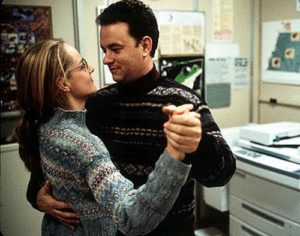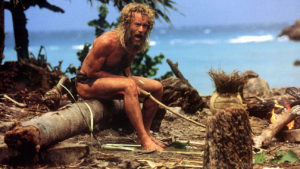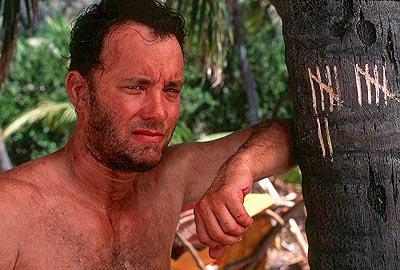“Cast Away” explores several themes – themes deeper than the usual lost at sea film – and thus presents a deeper picture than expected at first glance. It’s greatest assets are the desolate island that is its home, and the casting of Tom Hanks – both of which are utilized to near perfection. It starts with a human element and ends with one – which it has been criticized for by film critics such as Roger Ebert who imply the time Hanks spends lost at sea are the real story. But I disagree. The real story here is not one of special effects or isolation, but the triumph of the human spirit over the toughest of odds.
That Hanks’ Chuck Nolan is a clinical, work by the clock Fed Ex employee is only pat of this movie’s charm. Nolan is not so ruled by psychosis as Hanks’ character was in the hysterical “Turner & Hooch,” but is close. He jokingly mails himself a timer from Tennessee to Russia to prove that its readout of 87 hours is much too long. “Next thing you know we’ll be the U.S. Mail,” he jokes. He’s backed by supporting characters, such as a colleague who’s wife is battling cancer, and his supportive girlfriend Kelly, played by Helen Hunt with that same lovable and everywoman persona she exhibited in the solid “Twister.”
Nolan’s world is twisted upside down, however, when his plane crashes over the endless ocean, just days before New Years. He washes up on a deserted yet beautiful island, where quick attempts at requesting help are lost as he has no radio or telecommunications of any kind. Days become weeks, which become years. It isn’t long before Nolan feels he will never be rescued.

“Cast Away” is directed by Robert Zemeckis, the mind that brought us such films as “Death Becomes Her” and “Back to the Future.” Here, however, his aim is focused, his direction spot on, humor and sci fi cast aside for a deeper, more inclusive picture.
The first thing Zemeckis does right is in hiring Don Burgess as cinematographer, who highlights the films most desperate sequences well. The piece de resistance of the entire film is certainly the plane crash, which is recorded at a higher level than the rest of the film, and truly captures the fright of crashing into a violent ocean. Nolan washes up in but a simple raft, finding himself on an island with picturesque waves and vistas, but seeming little to eat. He first spells help on the sand by drawing with his foot. When this is washed away, he builds a more permanent structure with logs. For a man once ruled by time, patience and innovation are now his only allies.
The film also succeeds in the absolute solitude that it casts its protagonist in. For the entire time that Nolan is on the island, he speaks little, and Zemeckis doesn’t ruin this isolation by showing us scenes of his loved ones back home. The entirety of his island stay is simply Nolan foraging for food, making feeble attempts at escape, and contemplating his less and less hopeful rescue thoughts, and, in the film’s most desperate sequence, suicide.
Nolan becomes quite resourceful, learning how to count the days and use several washed up Fed Ex packages to his advantage, such as making a pair of sandals out of a man’s too small sized shoes and rope out of videotape. The film’s most awesome sequence is certainly when Nolan, who has been trying for seeming weeks, produces fire with a fire plow. We see the accomplishment of such a primitive tool and the joy it brings him. The by the clock Nolan has been replaced by a primitive man who has turned desperation into survival – though he never gives up hope of seeing his loved ones again.
 In a perfect piece of scriptwriting, Nolan’s only friend becomes a volleyball he converses with named Wilson. Only in a movie with this level of sophistication do we glean that Nolan’s “friendship” with Wilson is necessary and not satire. Their bond makes up for some of the most powerful scenes in the entire film.
In a perfect piece of scriptwriting, Nolan’s only friend becomes a volleyball he converses with named Wilson. Only in a movie with this level of sophistication do we glean that Nolan’s “friendship” with Wilson is necessary and not satire. Their bond makes up for some of the most powerful scenes in the entire film.
“Cast Away” is a brilliant film. To say more about the film, especially its bittersweet and touching ending, is to give away too much. This is a film that is captivating from start to finish, and a film that is as important during its first and third act as it is during its powerful middle. If you haven’t seen the film, do yourself a favor and rent it right away. And for those who haven’t seen it in quite some time, a second viewing reminds one of why it was so powerful in the first place.
– by Mark Ziobro


